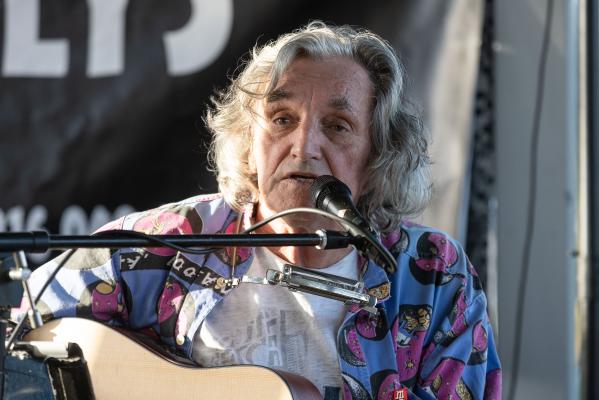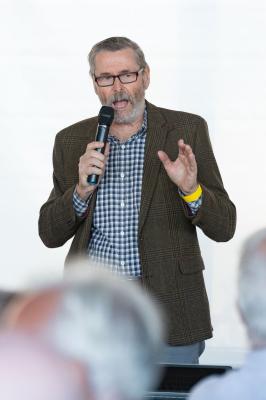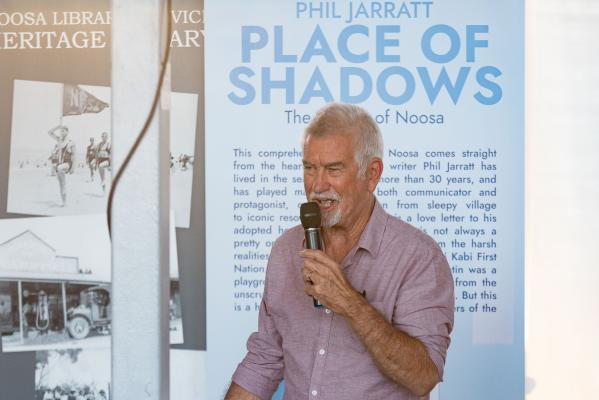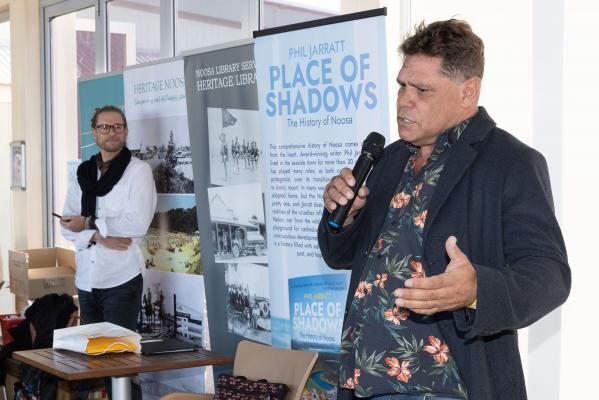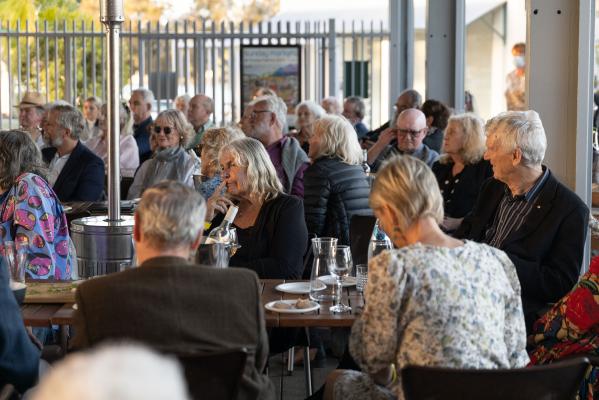Author, publisher, editor, filmmaker, surfer and Noosa Today journalist Phil Jarratt impressed both his publisher and playwright David Williamson with his latest book on the history of Noosa, though there were some initial reservations.
At the launch of Place of Shadows at Harbour Wine Bar at Noosa Marina last Friday, Boolarong Press publisher Dan Kelly told guests he thought Phil was a “tired, old surfer” when they first met and was surprised at the “quality of writing” in his book.
Mr Williamson said Phil’s book was no “puff piece promoting Noosa” but “a thoroughly researched and beautifully written real history of how Noosa became what it is today”.
Place of Shadows won high praise from Australia’s most successful and tallest playwright who repeated the sentiments he wrote on the book’s cover, saying, “Phil, with panache and clarity, takes us through the history that moved Noosa from our shameful beginning to its present uber desirability and suggests cogent ways to address the very real problems that our past and present force us to face”.
The launch itself brought together an array of prominent figures and pioneering descendants from Noosa’s history from Kabi Kabi Elder Brian Warner to former Noosa mayors, described by Phil as “heroes of change over the last 50 years”. All were treated to the soulful tunes of Noosa legend Barry Charles and a summing up of Phil’s historical account from David Williamson.
“It tells grippingly and compellingly the story of how our original inhabitants, the Kabi Kabi, who lived in harmony with the lands around Noosa for at least 5000, years were brutally displaced by white settlers originally intent on reaping the profits of the cedar forests which were once part of our ecology,” Williamson said.
“The Kabi Kabi, by the end of the century, had been reduced to a demoralised rump, and to save the inhabitants the embarrassment of seeing them around the place, they were all shipped off to a reservation that really amounted to a prison camp, three hours inland at Cherbourg.
The potential of Noosa for tourism to replace the fading timber industry was recognised at the turn of the 20th century when in 1886 developer Walter Hay convinced Widgie Shire to build a bridge across Weyba Creek, linking Noosa Heads to Tewantin and access to Gympie Terrace.
By 1907 Laguna House with 50 beds was built in Hastings Street where Aromas is now.
“The Queensland Government was sure the state had a tourist future and racked its brains for a great selling point,” Williamson said.
“The best they could come up with was that Queensland had the lowest death rate per thousand than any other state,” he said.
“In the ’20s banana growing was thought to be Noosa’s economic salvation but this too fizzled.
“Oysters from Lake Weyba was the next hope but they were soon overfished.
“Then after the war, the surfing attractions of Noosa were first discovered and, on another front, a new tree change generation started to arrive. Thankfully, for those of us who don’t want to see Noosa become another Gold Coast, they included the indomitable Dr Arthur Harrold and his indomitable wife Marjorie and a band of nature lovers who formed the Noosa Parks Association. The story of how Arthur and Marjorie and others fought a clever and prolonged campaign to make sure Noosa National Park became a reality for us and future generations is an inspiring story deftly told by Phil.”
The surfer invasion arrived in the ’60s, followed by the Victorian invasion in the ’70s and the arrival of dubious racing identities and dubious property deals.
“Thankfully along with the buccaneers can a new infusion of culinary excellence led by ex-theatre nurse Leonie Palmer and French expatriate Luc Turschwell,” Williamson said.
“By the mid ’80s Dr Harrold had been joined by environmental warriors Michael Gloster, Noel Playford and Bob Abbot. Michael, bearded and duo blessed with the gentlest of bedside manners wasn’t universally loved but as Phil points out his achievements to safeguard the natural environment are considerable with the crowning achievement being his brilliant strategy, aided by then Mayor Tony Wellington to add 2400 hectares of National Park in the Yurol-Ringtail acquisition to seal Noosa forever with a crescent of National Parks.
“Phil brings us right up to the present to point out that the very forces that have fought to stop us becoming a nightmare of overdevelopment have made us such a desirable destination of natural beauty and culinary excellence that we are in great danger of being loved to death.”
Phil thanked the many people who helped him bring to fruition his idea to write a history of Noosa that was brought to life with the impetus of pandemic isolation.
Paying tribute to writer and environmental campaigner Nancy Cato Phil said he hoped to pick up where she left off.
“There’s a lot of love for Noosa in this book,” he said.
Place of Shadows is available from book stores across Noosa.

